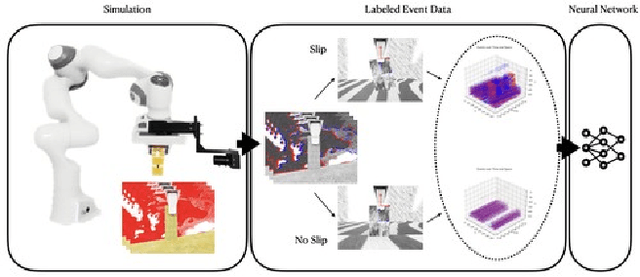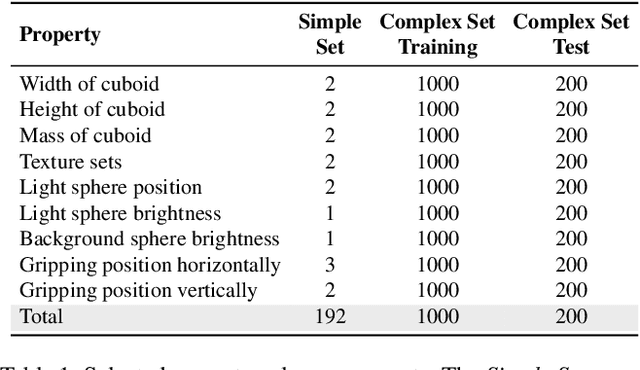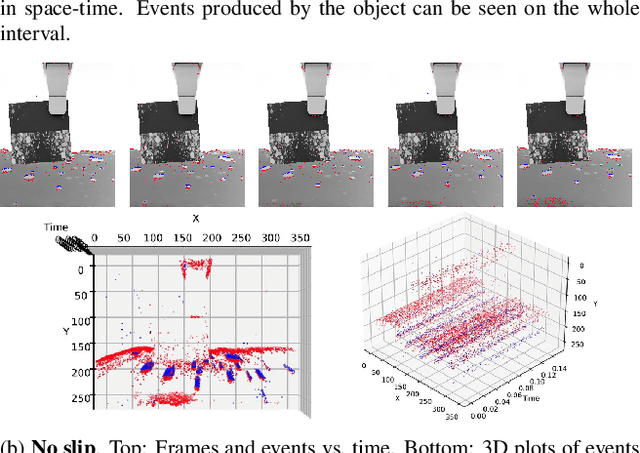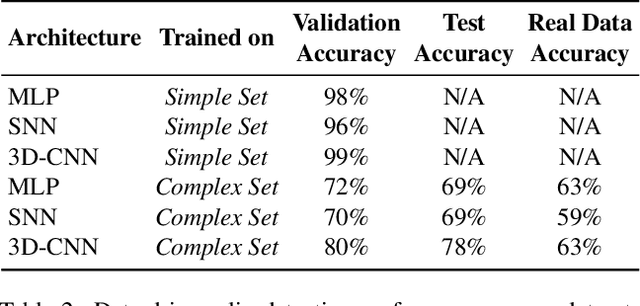Guillermo Gallego
Iterative Event-based Motion Segmentation by Variational Contrast Maximization
Apr 25, 2025Abstract:Event cameras provide rich signals that are suitable for motion estimation since they respond to changes in the scene. As any visual changes in the scene produce event data, it is paramount to classify the data into different motions (i.e., motion segmentation), which is useful for various tasks such as object detection and visual servoing. We propose an iterative motion segmentation method, by classifying events into background (e.g., dominant motion hypothesis) and foreground (independent motion residuals), thus extending the Contrast Maximization framework. Experimental results demonstrate that the proposed method successfully classifies event clusters both for public and self-recorded datasets, producing sharp, motion-compensated edge-like images. The proposed method achieves state-of-the-art accuracy on moving object detection benchmarks with an improvement of over 30%, and demonstrates its possibility of applying to more complex and noisy real-world scenes. We hope this work broadens the sensitivity of Contrast Maximization with respect to both motion parameters and input events, thus contributing to theoretical advancements in event-based motion segmentation estimation. https://github.com/aoki-media-lab/event_based_segmentation_vcmax
DERD-Net: Learning Depth from Event-based Ray Densities
Apr 22, 2025Abstract:Event cameras offer a promising avenue for multi-view stereo depth estimation and Simultaneous Localization And Mapping (SLAM) due to their ability to detect blur-free 3D edges at high-speed and over broad illumination conditions. However, traditional deep learning frameworks designed for conventional cameras struggle with the asynchronous, stream-like nature of event data, as their architectures are optimized for discrete, image-like inputs. We propose a scalable, flexible and adaptable framework for pixel-wise depth estimation with event cameras in both monocular and stereo setups. The 3D scene structure is encoded into disparity space images (DSIs), representing spatial densities of rays obtained by back-projecting events into space via known camera poses. Our neural network processes local subregions of the DSIs combining 3D convolutions and a recurrent structure to recognize valuable patterns for depth prediction. Local processing enables fast inference with full parallelization and ensures constant ultra-low model complexity and memory costs, regardless of camera resolution. Experiments on standard benchmarks (MVSEC and DSEC datasets) demonstrate unprecedented effectiveness: (i) using purely monocular data, our method achieves comparable results to existing stereo methods; (ii) when applied to stereo data, it strongly outperforms all state-of-the-art (SOTA) approaches, reducing the mean absolute error by at least 42%; (iii) our method also allows for increases in depth completeness by more than 3-fold while still yielding a reduction in median absolute error of at least 30%. Given its remarkable performance and effective processing of event-data, our framework holds strong potential to become a standard approach for using deep learning for event-based depth estimation and SLAM. Project page: https://github.com/tub-rip/DERD-Net
Simultaneous Motion And Noise Estimation with Event Cameras
Apr 05, 2025



Abstract:Event cameras are emerging vision sensors, whose noise is challenging to characterize. Existing denoising methods for event cameras consider other tasks such as motion estimation separately (i.e., sequentially after denoising). However, motion is an intrinsic part of event data, since scene edges cannot be sensed without motion. This work proposes, to the best of our knowledge, the first method that simultaneously estimates motion in its various forms (e.g., ego-motion, optical flow) and noise. The method is flexible, as it allows replacing the 1-step motion estimation of the widely-used Contrast Maximization framework with any other motion estimator, such as deep neural networks. The experiments show that the proposed method achieves state-of-the-art results on the E-MLB denoising benchmark and competitive results on the DND21 benchmark, while showing its efficacy on motion estimation and intensity reconstruction tasks. We believe that the proposed approach contributes to strengthening the theory of event-data denoising, as well as impacting practical denoising use-cases, as we release the code upon acceptance. Project page: https://github.com/tub-rip/ESMD
Unsupervised Joint Learning of Optical Flow and Intensity with Event Cameras
Mar 21, 2025Abstract:Event cameras rely on motion to obtain information about scene appearance. In other words, for event cameras, motion and appearance are seen both or neither, which are encoded in the output event stream. Previous works consider recovering these two visual quantities as separate tasks, which does not fit with the nature of event cameras and neglects the inherent relations between both tasks. In this paper, we propose an unsupervised learning framework that jointly estimates optical flow (motion) and image intensity (appearance), with a single network. Starting from the event generation model, we newly derive the event-based photometric error as a function of optical flow and image intensity, which is further combined with the contrast maximization framework, yielding a comprehensive loss function that provides proper constraints for both flow and intensity estimation. Exhaustive experiments show that our model achieves state-of-the-art performance for both optical flow (achieves 20% and 25% improvement in EPE and AE respectively in the unsupervised learning category) and intensity estimation (produces competitive results with other baselines, particularly in high dynamic range scenarios). Last but not least, our model achieves shorter inference time than all the other optical flow models and many of the image reconstruction models, while they output only one quantity. Project page: https://github.com/tub-rip/e2fai
Combined Physics and Event Camera Simulator for Slip Detection
Mar 05, 2025



Abstract:Robot manipulation is a common task in fields like industrial manufacturing. Detecting when objects slip from a robot's grasp is crucial for safe and reliable operation. Event cameras, which register pixel-level brightness changes at high temporal resolution (called ``events''), offer an elegant feature when mounted on a robot's end effector: since they only detect motion relative to their viewpoint, a properly grasped object produces no events, while a slipping object immediately triggers them. To research this feature, representative datasets are essential, both for analytic approaches and for training machine learning models. The majority of current research on slip detection with event-based data is done on real-world scenarios and manual data collection, as well as additional setups for data labeling. This can result in a significant increase in the time required for data collection, a lack of flexibility in scene setups, and a high level of complexity in the repetition of experiments. This paper presents a simulation pipeline for generating slip data using the described camera-gripper configuration in a robot arm, and demonstrates its effectiveness through initial data-driven experiments. The use of a simulator, once it is set up, has the potential to reduce the time spent on data collection, provide the ability to alter the setup at any time, simplify the process of repetition and the generation of arbitrarily large data sets. Two distinct datasets were created and validated through visual inspection and artificial neural networks (ANNs). Visual inspection confirmed photorealistic frame generation and accurate slip modeling, while three ANNs trained on this data achieved high validation accuracy and demonstrated good generalization capabilities on a separate test set, along with initial applicability to real-world data. Project page: https://github.com/tub-rip/event_slip
* 9 pages, 8 figures, 2 tables, https://github.com/tub-rip/event_slip
Event-based Photometric Bundle Adjustment
Dec 18, 2024



Abstract:We tackle the problem of bundle adjustment (i.e., simultaneous refinement of camera poses and scene map) for a purely rotating event camera. Starting from first principles, we formulate the problem as a classical non-linear least squares optimization. The photometric error is defined using the event generation model directly in the camera rotations and the semi-dense scene brightness that triggers the events. We leverage the sparsity of event data to design a tractable Levenberg-Marquardt solver that handles the very large number of variables involved. To the best of our knowledge, our method, which we call Event-based Photometric Bundle Adjustment (EPBA), is the first event-only photometric bundle adjustment method that works on the brightness map directly and exploits the space-time characteristics of event data, without having to convert events into image-like representations. Comprehensive experiments on both synthetic and real-world datasets demonstrate EPBA's effectiveness in decreasing the photometric error (by up to 90%), yielding results of unparalleled quality. The refined maps reveal details that were hidden using prior state-of-the-art rotation-only estimation methods. The experiments on modern high-resolution event cameras show the applicability of EPBA to panoramic imaging in various scenarios (without map initialization, at multiple resolutions, and in combination with other methods, such as IMU dead reckoning or previous event-based rotation estimation methods). We make the source code publicly available. https://github.com/tub-rip/epba
Data Pruning Can Do More: A Comprehensive Data Pruning Approach for Object Re-identification
Dec 13, 2024



Abstract:Previous studies have demonstrated that not each sample in a dataset is of equal importance during training. Data pruning aims to remove less important or informative samples while still achieving comparable results as training on the original (untruncated) dataset, thereby reducing storage and training costs. However, the majority of data pruning methods are applied to image classification tasks. To our knowledge, this work is the first to explore the feasibility of these pruning methods applied to object re-identification (ReID) tasks, while also presenting a more comprehensive data pruning approach. By fully leveraging the logit history during training, our approach offers a more accurate and comprehensive metric for quantifying sample importance, as well as correcting mislabeled samples and recognizing outliers. Furthermore, our approach is highly efficient, reducing the cost of importance score estimation by 10 times compared to existing methods. Our approach is a plug-and-play, architecture-agnostic framework that can eliminate/reduce 35%, 30%, and 5% of samples/training time on the VeRi, MSMT17 and Market1501 datasets, respectively, with negligible loss in accuracy (< 0.1%). The lists of important, mislabeled, and outlier samples from these ReID datasets are available at https://github.com/Zi-Y/data-pruning-reid.
Event-based Tracking of Any Point with Motion-Robust Correlation Features
Nov 28, 2024



Abstract:Tracking any point (TAP) recently shifted the motion estimation paradigm from focusing on individual salient points with local templates to tracking arbitrary points with global image contexts. However, while research has mostly focused on driving the accuracy of models in nominal settings, addressing scenarios with difficult lighting conditions and high-speed motions remains out of reach due to the limitations of the sensor. This work addresses this challenge with the first event camera-based TAP method. It leverages the high temporal resolution and high dynamic range of event cameras for robust high-speed tracking, and the global contexts in TAP methods to handle asynchronous and sparse event measurements. We further extend the TAP framework to handle event feature variations induced by motion - thereby addressing an open challenge in purely event-based tracking - with a novel feature alignment loss which ensures the learning of motion-robust features. Our method is trained with data from a new data generation pipeline and systematically ablated across all design decisions. Our method shows strong cross-dataset generalization and performs 135% better on the average Jaccard metric than the baselines. Moreover, on an established feature tracking benchmark, it achieves a 19% improvement over the previous best event-only method and even surpasses the previous best events-and-frames method by 3.7%.
ESVO2: Direct Visual-Inertial Odometry with Stereo Event Cameras
Oct 12, 2024



Abstract:Event-based visual odometry is a specific branch of visual Simultaneous Localization and Mapping (SLAM) techniques, which aims at solving tracking and mapping sub-problems in parallel by exploiting the special working principles of neuromorphic (ie, event-based) cameras. Due to the motion-dependent nature of event data, explicit data association ie, feature matching under large-baseline view-point changes is hardly established, making direct methods a more rational choice. However, state-of-the-art direct methods are limited by the high computational complexity of the mapping sub-problem and the degeneracy of camera pose tracking in certain degrees of freedom (DoF) in rotation. In this paper, we resolve these issues by building an event-based stereo visual-inertial odometry system on top of our previous direct pipeline Event-based Stereo Visual Odometry. Specifically, to speed up the mapping operation, we propose an efficient strategy for sampling contour points according to the local dynamics of events. The mapping performance is also improved in terms of structure completeness and local smoothness by merging the temporal stereo and static stereo results. To circumvent the degeneracy of camera pose tracking in recovering the pitch and yaw components of general six-DoF motion, we introduce IMU measurements as motion priors via pre-integration. To this end, a compact back-end is proposed for continuously updating the IMU bias and predicting the linear velocity, enabling an accurate motion prediction for camera pose tracking. The resulting system scales well with modern high-resolution event cameras and leads to better global positioning accuracy in large-scale outdoor environments. Extensive evaluations on five publicly available datasets featuring different resolutions and scenarios justify the superior performance of the proposed system against five state-of-the-art methods.
Fourier-based Action Recognition for Wildlife Behavior Quantification with Event Cameras
Oct 09, 2024Abstract:Event cameras are novel bio-inspired vision sensors that measure pixel-wise brightness changes asynchronously instead of images at a given frame rate. They offer promising advantages, namely a high dynamic range, low latency, and minimal motion blur. Modern computer vision algorithms often rely on artificial neural network approaches, which require image-like representations of the data and cannot fully exploit the characteristics of event data. We propose approaches to action recognition based on the Fourier Transform. The approaches are intended to recognize oscillating motion patterns commonly present in nature. In particular, we apply our approaches to a recent dataset of breeding penguins annotated for "ecstatic display", a behavior where the observed penguins flap their wings at a certain frequency. We find that our approaches are both simple and effective, producing slightly lower results than a deep neural network (DNN) while relying just on a tiny fraction of the parameters compared to the DNN (five orders of magnitude fewer parameters). They work well despite the uncontrolled, diverse data present in the dataset. We hope this work opens a new perspective on event-based processing and action recognition.
 Add to Chrome
Add to Chrome Add to Firefox
Add to Firefox Add to Edge
Add to Edge